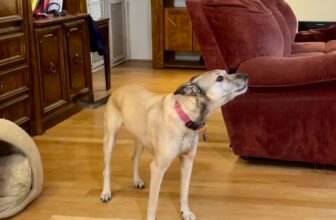

Get Ready
Is your dog scared of fireworks? Don’t wait until the holiday hits. Even with just a couple days’ lead time, you can make a plan and act now to help your dog be less afraid of the unpredictable scary sounds of fireworks, firecrackers, whistles, and even guns.
Here are some things you can do starting today.
1. Call your vet about medications.
If your dog gets very anxious about noises and you have never talked to your vet about it, do so now. Sound sensitivities and phobias are serious conditions. Only a veterinarian can diagnose and treat your dog. Call them today. They may prescribe something to help. And if you can’t get in before the holiday, do your best with some of the other ideas here to get through it and call your vet as soon as you can. This is a long-term problem. Clinical sound phobias usually get worse and are not something to be taken lightly. See the statement from a veterinarian about medical options at the end of this list.
2. Use ad hoc counterconditioning to noises.
Get some great treats and start carrying them around. Whenever there is any kind of sudden or startling noise, including stray bangs and booms as people test their noisemakers, rain treats down on your dog. Use those special treats only for noises; don’t pass them out for nice behavior (use something else for that!), and don’t ask for any behavior from your dog when the noise occurs. Just give the special treats. Your dog may start to come to you when she hears a sound; that’s a feature, not a bug.
You may wonder why I am not recommending using an app, CD, or YouTube video with fireworks sounds to “practice” with. Performing desensitization/counterconditioning with sounds is tricky. People who haven’t done DS/CC before run a real risk of scaring their dogs further instead of helping them. This is why I am suggesting ad hoc counterconditioning, which uses environmental noises that are happening anyway (that’s the “ad hoc” part). This is an evidence-based method (Riemer, 2020). Save the formal training for after the holiday, when your dog is less likely to be exposed accidentally to the scary sounds.
3. Create a safe place.
Make (or adapt) a safe place for your dog. Keep in mind that the flashes of light that come with big fireworks displays can be scary too, so consider a method to temporarily darken any windows nearby. Also, low-frequency booms can’t be “soundproofed” against except with materials that are much too big to use inside a house. Get the best protection you can in a basement or your most internal room. Despite the marketing claims, dog crates with walls a few inches thick can’t attenuate low-frequency sounds to an effective degree. But if a crate is your dog’s safe place, that’s great. Here are some examples of safe places for dogs.
It’s hard on us humans to let our beloved dogs hide. We want to pull them out to be with us so we can show them that everything is all right. But everything is not all right for a dog who fears these sounds, and she has chosen the best way she knows to cope. You could try sitting nearby and tossing treats to your dog if she will eat, but that could put pressure on her. Unless she is obviously glad for your presence, leave her alone, quietly checking on her from time to time, until she is ready to come out.


4. Use sound masking.
Experiment with sound masking to find out what is most helpful for your situation. This article I wrote for Whole Dog Journal goes into detail about how to choose a masking noise. You can try recorded brown, pink, or white noise, a fan, natural noise, or music to mask the pops and booms. (Even a noisy food toy can be helpful.)
By the way, the evidence for music having special relaxing qualities for dogs is shaky, and special music marketed as adapted for dogs has performed the worst in studies (Lindig et al., 2020). So pick your music with masking in mind; masking is evidence-based (Gelfand, 2017).
And here’s a tip: the lower the frequencies included in the masking or music, the better it can hide those low-pitched booms (Kinsler et al., 2000, p.318–320). So if your dogs are already habituated to pounding rock music or some other music with a lot of bass or percussion, play it! And play it on your best sound system to include those low frequencies. It can mask some of the scary noises coming from outside your house more effectively. Taiko drumming is great if your dogs are accustomed to it. You can buy a few songs and loop them or find some on YouTube. But be certain that the music itself doesn’t scare your dogs, first. If they are already sensitive to booms, it probably will.


Household appliances can help. In addition to fans, you can run the dryer (no heat) with a pair of sports shoes in it for some booms that will probably be familiar and not scary. Schedule the washing machine and dishwasher runs you would do anyway for the scary period, and you can even run a robot vacuum if you have one and your dogs aren’t scared of it. You’ll need to find the line of best fit for your dogs.
A great resource for some households is the Bang-Dog Playlist from Triplet Noir Studios. These are heavy metal selections (be aware that some of the language is not family-friendly). Before anyone mentions it: heavy metal has not ranked well in the dogs and music studies, tending to make shelter dogs more agitated (Kogan et al., 2012). That’s not surprising. But if you play it already and your dogs are fine with it, they are habituated. In that case, this music could be the very thing for you and your dog.
5. Practice going out.
Make a plan for taking your dog out to potty. Do you know when the noise is usually at its worst and can you work around that? Are your fences and/or leash and harness secure? If your dog is not used to being on-leash for potty time, start practicing now, including getting the harness on. Dogs who are usually calm have been known to panic and run off on noisy holidays. Don’t let that happen. Keep your gates locked, your dogs’ ID tags on, and put some redundancy into your safety system. Make sure the whole family understands the plan and what’s at stake.
6. Comfort your dog if that helps.


LOSE that idea that there’s something wrong with comforting your dog, if that’s what your dog wants. Helping a dog through a tough time is not “coddling.” Assess what is most helpful to your dog: a cuddle, food, or a fun game after every scary noise, some lap time, sweet talk, being in their crate with a food toy, or hiding by themselves in a secluded place. Then help them do it. Again, if they want to hide, let them.
A Message from a Veterinarian Who Specializes in Behavior
If you see your vet now to discuss prescription drug possibilities, you have time to make sure they work for your dog and your vet can adjust them if necessary. There are new products on the market, as well as several options that have been around for years. Here is what Dr. Lynn Honeckman, veterinary behavior resident, says about the benefits of medications.
Now is the perfect time to add an anti-anxiety medication to your firework-preparation kit. The right medication will help your pet remain calm while not causing significant sedation. It is important to practice trials of medication before the actual holiday so that the effect can be properly tested.
There are a variety of medications or combinations that your veterinarian might prescribe. Medications such as Sileo, clonidine, alprazolam, gabapentin, or trazodone are the best to try due to their quick onset of action (typically within an hour) and short duration of effect (4–6 hours).
Medications such as acepromazine should be avoided as they provide sedation without the anti-anxiety effect, and could potentially cause an increase in fear.
Pets who suffer severe fear may need a combination of medications to achieve the appropriate effect, and doses may need to be increased or decreased during the trial phase. Ultimately, there is no reason to allow a pet to suffer from noise phobia. Now is the perfect time to talk with your veterinarian.
Dr. Lynn Honeckman, Veterinary Behavior Solutions, Orlando, Florida
Copyright 2023 Eileen Anderson
References
- Gelfand, S. A. (2017). Hearing: An introduction to psychological and physiological acoustics. CRC Press.
- Kinsler, L. E., Frey, A. R., Coppens, A. B., & Sanders, J. V. (2000). Fundamentals of acoustics. John Wiley & Sons.
- Kogan, L. R., Schoenfeld-Tacher, R., & Simon, A. A. (2012). Behavioral effects of auditory stimulation on kenneled dogs. Journal of Veterinary Behavior, 7(5), 268-275.
- Lindig, A. M., McGreevy, P. D., & Crean, A. J. (2020). Musical dogs: A review of the influence of auditory enrichment on canine health and behavior. Animals, 10(1), 127.
- Riemer, S. (2020). Effectiveness of treatments for firework fears in dogs. Journal of veterinary behavior, 37, 61-70.
Photo Credits
- Image of firecracker exploding has been placed in the public domain; thank you to Andy Thrasher on Flickr.
- Image of brown dog’s head in profile copyright Eileen Anderson.
- Image of a Sony Bluetooth speaker copyright Eileen Anderson.
- Image of a black and tan dog in a woman’s lap copyright Eileen Anderson.






